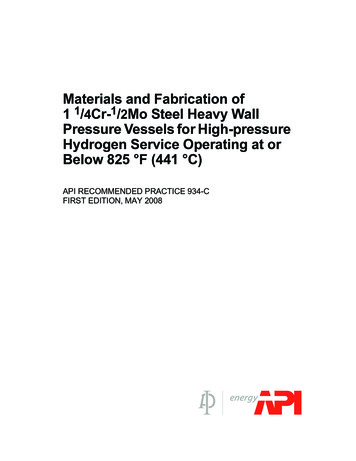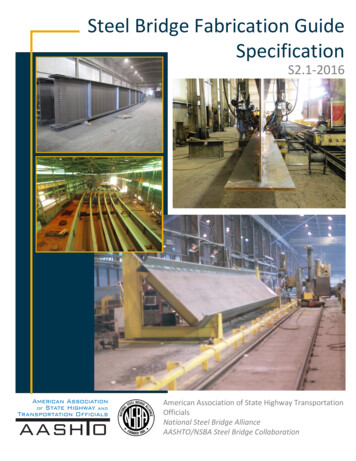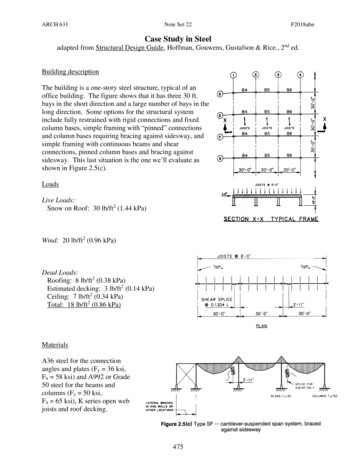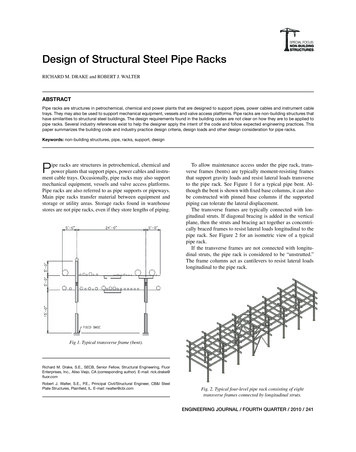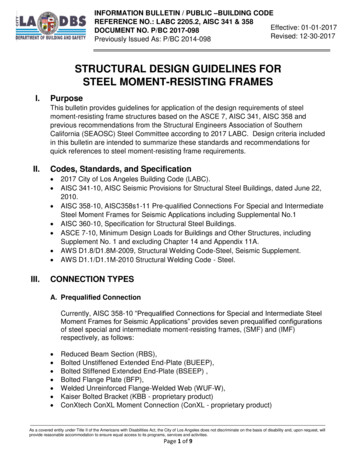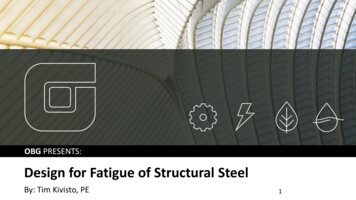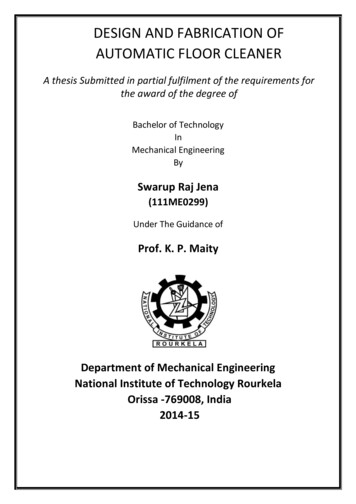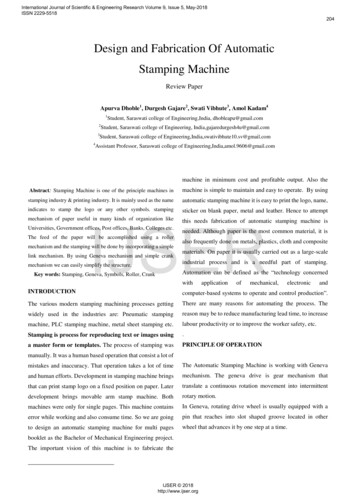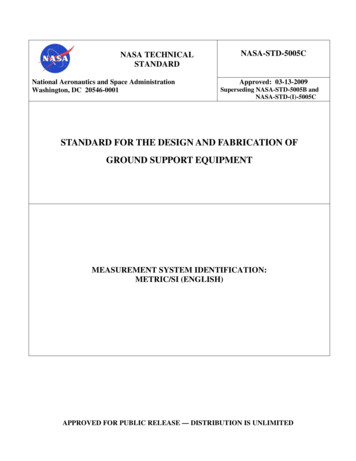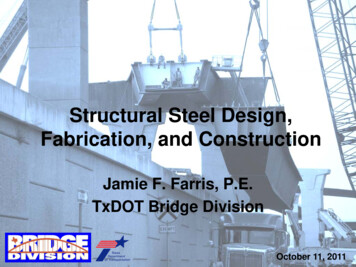
Transcription
Structural Steel Design,Fabrication, and ConstructionJamie F. Farris, P.E.TxDOT Bridge DivisionOctober 11, 2011
DesignFabricationConstructionNSBA/AASHTO
Bridge Design Manual - LRFD
TxDOT Preferred PracticesTexas SteelQuality Council teel Mill reps
Material Selection
Unpainted Weathering Steel– Preferred– A 709 Grades 50W and HPS 70W– More economical– Consider location conditions before choosing– Use details to prevent concrete staining
Prevent ConcreteStainingWeathering Steel Include drip tabs onall girders Additional options– Stainless steel trays– Paint area over Bent
Painted Steel– System IV – noncoastal newconstruction– System III – coastalnew construction– More info - See Item446 of TxDOT SpecBook
Span Configuration & GeometryLExterior 1.2L to 1.3LInteriorLExterior3 and 4 span continuous – PreferredInterior Spans 20-30% longer then End SpansCheck uplift at the ends of continuous girdersAvoid high skews or major differentials wherepossible
Girder Spacing I-girders– Limit CL-CL spa to 10 ft– Min of 4 girders for vehicular bridge span Tub girders– Limit web spacing to 10 ft– Min of 3 girders for vehicular bridge span Consider use of PCPs for straight girders
I-Shaped Plate Girders
Geometric Constraints forStraight Girders0.25DMin.0.75 in Min.3.00 in Max.Flange Width D/4Flange Width 15 in¾ in Flange Thick 3 inWeb Thick ½ inD0.50 inMin.
Geometric Constraints forCurved Girders0.25DMin.Flange Width D/41.00 in Min.3.00 in Max.Flange Width 15 in1 in Flange Thick 3 inWeb Thick ½ inD0.50 inMin.
Flange Criteria Flange Width– Constant– Transitions at field splices– Top Bottom Flange Thickness– Use 10 ft min length– Use only a few sizes– In lieu of lateral bracing – flange thickness– Use similar thicknessesacross girders
Flange Criteria Flange splices – extend thicker flangesbeyond theoretical flange splice locationTheoretical Location
Web Criteria Web Depth– Whole inch increments– Dapped Ends: No more than 40% of webdepth– Do not use haunched webs Web Thickness– Eliminate need for transverse stiffeners– Discourage use of fully stiffened webdesigns– Optimal designs have few sizes
Web Criteria Don’t use Longitudinal stiffeners unlessweb depth 120 inPresentfabrication andfatigue problems
Field Splices Show in plans as welded Offer bolted splice option Locate at points of DLcontraflexure Girder field length 130 ft max Limit shipping width to 6 ft andheight to 9 ft Web splice locations at least10’ apart
Bolted Field Splices Galvanized bolts forpainted steel 1”, 7/8”, ¾” Dia Class A surfaceconditions Splice PL thickness ½” Add 1/8” – ¼” tomin edge distancesin AASHTO LRFD
Splice Fill Plates Steel grade specified for girders – notavailable in thicknesses less than 3/8” Allow optional fill plate material (A 606, A570, etc.) Spec Book 447.4.B
A325 vs. A490 Bolts Contractors preferA325 A325 bolts can beretightened A490 bolts aresensitive to tighteningprocedures A490 bolts requireimpact wrenches thatmight not be available
Diaphragms & X-Frames Max Spacing– Straight 30 ft– Curved 20 ft Provide at all endbearings Straight - Set parallelto skew up to 20o. Setradial beyond 20o Curved – set radial togirders
X-frame Half Pipe StiffenersSkewed Bridges Research Project0-5701 Gives girdershigher bucklingcapacities Serves as abearing stiffener Coming soon:Added to SGMDStandard
Lean On BracingStraight Bridges Research Project 0-1772Struts transfer forces to 1 or 2 X-framesMinimize LL induced brace forcesReducing number of braces
Stud Connectors Full length ofgirder Min longitudinalSpa 4d SGMD Standard Not required ontop of flange spliceplates
Bearings Select from TxDOTSGEB standard Triple check bearingseat elevations Avoid costly HLMR,disc, pot bearings Bent Cap geometry
Steel Tub Girders Only use if this isthe best solution Consider for long,narrow, curved,bridges with tightradius NSBA “PracticalSteel Tub GirderDesign”
Tub Girders Constant shape Rotated with x-slope Top flange and Web –same requirements asI-girder Avoid details morecritical than Cat. C
Bottom Tension Flange ¾” thick w/t 80 Classified as fracturecritical for 2-girder spans All bottom flange edges– extend 2 in beyondweb CL
Inspection Access
Slabbing and StrippingGirder ElevationTop View
Slabbing and StrippingMultiple Head Cutting Bed Strips Out Flanges FromWider Plates
Narrow Gap Electroslag WeldingWelding TimeApprox. 10- 20%of multiple passweldMinutesversusHours
Analyze girder system using grid analysis Predict the behavior of girder systemonce bridge is fully constructed
Critical Stages of Stability Girder Erection Before concrete deck placement
Research Study 0-5574 Curved Plate Girder Design for Safeand Economical Construction– Justify recommendations in PreferredPractices– Create uniformity among analyticalrequirements of curved I-girders duringearly stages of construction– Girder erection and concrete slabplacement
Research Study 0-5574 Field Monitoring Parametric FiniteElement Modeling Survey of GirderErection Practices PC BasedAnalytical tools
Lifting Point Locations
Shoring Issues High costs Prematureremoval Site access issues
ANALYTICAL TOOLSUT Lift 1.1 Spreadsheet Behavior of girdersegments duringlifting Determines optimallift locations Girderdeformations Predicts girdertwist
ANALYTICAL TOOLS 3D Finite ElementProgram Partiallyconstructed girdersystems Staged deckplacementUT Bridge 1.5
National Steel Bridge Alliance
AASHTO/NSBA
Guidelines for SteelGirder Analysis Shop Detail DrawingReview Fabrication Sample OwnersQuality AssuranceManual Erection Guide Spec Coating SystemsGuide
AASHTO/NSBA
Final published inEarly 2012 23 Chapters including–––––––AnalysisLoad CombinationsSplice DesignSubstructure DesignBearing DesignDeck DesignDesign for Fatigue 7 Example Problems
AcknowledgementsBrian Merrill, TxDOT BRGJohn Holt, TxDOT BRGTom Schwerdt, TxDOT CSTMike Hyzak, TxDOT BRGGreg Turco, TxDOT BRGMichelle Romage-Chambers, TxDOT BRGTodd Helwig, University of TexasKarl Frank, Hirschfeld IndustriesJason Stith, Michael Baker, IncUniversity of Texas ResearchersTxDOT BRG Construction Section
Structural Steel Design, Fabrication, and Construction Jamie F. Farris, P.E.

